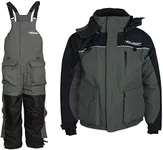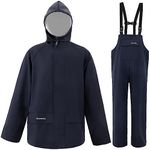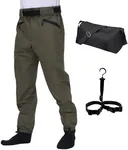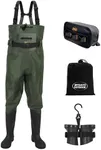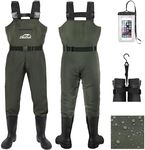Buying Guide for the Best Fishing Suit
Choosing the right fishing suit is essential for a comfortable and successful fishing experience. A good fishing suit will keep you warm, dry, and protected from the elements, allowing you to focus on catching fish rather than worrying about your comfort. When selecting a fishing suit, consider the environment you'll be fishing in, the weather conditions, and the type of fishing you'll be doing. Here are some key specifications to consider when picking the best fishing suit for you.MaterialThe material of a fishing suit is crucial because it determines the suit's durability, breathability, and waterproof capabilities. Common materials include Gore-Tex, nylon, and polyester. Gore-Tex is known for its excellent waterproof and breathable properties, making it ideal for harsh weather conditions. Nylon is lightweight and durable, while polyester is quick-drying and resistant to UV rays. Choose a material based on the weather conditions you'll be facing and the level of activity during your fishing trips.
WaterproofingWaterproofing is essential to keep you dry during wet conditions. Fishing suits come with different levels of waterproofing, often measured in millimeters (mm). A suit with a rating of 5,000mm to 10,000mm is suitable for light to moderate rain, while a rating of 10,000mm to 20,000mm is better for heavy rain and prolonged exposure to water. Consider the typical weather conditions in your fishing area and choose a suit with an appropriate waterproof rating to ensure you stay dry.
InsulationInsulation is important for maintaining body heat in cold weather. Fishing suits can have varying levels of insulation, from lightweight to heavy-duty. Lightweight insulation is suitable for mild weather and active fishing, while heavy-duty insulation is better for extremely cold conditions and less active fishing. Think about the temperatures you'll be fishing in and your activity level to determine the right amount of insulation for your needs.
BreathabilityBreathability refers to the suit's ability to allow moisture and sweat to escape, keeping you comfortable and dry from the inside. Breathability is often measured in grams (g) per square meter (m²) over 24 hours. A rating of 5,000g/m² to 10,000g/m² is suitable for moderate activity, while a rating of 10,000g/m² to 20,000g/m² is better for high-intensity activity. If you plan to be very active while fishing, choose a suit with higher breathability to prevent overheating and discomfort.
Fit and MobilityThe fit and mobility of a fishing suit are important for comfort and ease of movement. A suit that is too tight can restrict your movements, while one that is too loose can be cumbersome. Look for suits with adjustable features such as cuffs, waistbands, and hoods to customize the fit. Consider the type of fishing you'll be doing and choose a suit that allows for a full range of motion without being too bulky.
Pockets and StoragePockets and storage options are useful for keeping your fishing gear and personal items easily accessible. Look for suits with multiple pockets, including waterproof and zippered options, to keep your belongings safe and dry. Consider the amount of gear you typically carry and choose a suit with enough storage to meet your needs.
Hood and CollarA good hood and collar can provide extra protection against wind and rain. Look for suits with adjustable hoods that can be tightened to fit snugly around your head and face. A high collar can help keep your neck warm and dry. Consider the weather conditions you'll be facing and choose a suit with a hood and collar that offer adequate protection.


